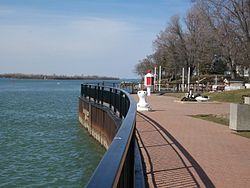| Amherstburg Royal Naval Dockyard | |
|---|---|
| Amherstburg, Ontario | |
 Site of the Dockyard at Navy Yard Park, Amherstburg | |
| Site information | |
| Type | Shipyard, dockyard |
| Controlled by | Provincial Marine/Royal Navy |
| Website | Amherstburg Navy Yard National Historic Site of Canada |
 | |
| Site history | |
| Built | 1796 |
| In use | 1796–1813 |
| Battles/wars | War of 1812 |
| Garrison information | |
| Garrison | Provincial Marine/Royal Navy |
| Designated | 1928 |
Amherstburg Royal Naval Dockyard was a Provincial Marine and then a Royal Navy yard from 1796 to 1813 located at Fort Amherstburg, Upper Canada, (now Amherstburg, Ontario) situated on the Detroit River. The yard comprised blockhouses, storehouses, magazine, wood yard and wharf. The yard was established in 1796 to support the Upper Canada Provincial Marine after Great Britain ceded a pre-existing shipyard on the Detroit River to the United States. Amherstburg Royal Naval Dockyard constructed four warships for the Lake Erie detachment of the Provincial Marine before and during the War of 1812. In 1813 the dockyard was abandoned and destroyed when the British retreated and never reopened. In 1928, the site was designated a National Historic Site of Canada.